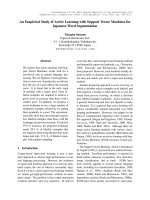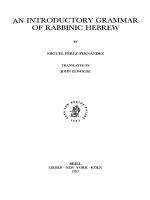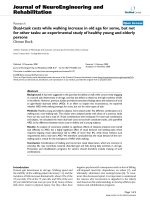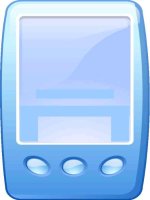- Trang chủ >>
- Khoa Học Tự Nhiên >>
- Vật lý
Mathematics for quantum mechanics; an introductory survey of operators, eigenvalues, and linear vector spaces
Bạn đang xem bản rút gọn của tài liệu. Xem và tải ngay bản đầy đủ của tài liệu tại đây (3.83 MB, 108 trang )
MatheInatics
for
QuantUIn Mechanics
An Introductory Sur"e..y of Operators,
Eigen"alues, and Linear Vector Spaces
John David Jackson
University of Illinois
w. A. Benjamin, Inc.
New York
www.pdfgrip.com
1962
MATHEMATICS FOR QUANTUM MECHANICS
An Introductory Survey
Copyright@ 1962 by W. A. Benjamin, Inc.
All rights reserved.
Library of Congress Catalog Card Number: 62-17526
Manufactured in the United States of America
The manuscript was received April 1, 1962,
and published July 20, 1962.
W. A. BENJAMIN, INC.
www.pdfgrip.com
Editor's Foreword
Everyone concerned with the teaching of physics at the advanced
undergraduate or graduate level is aware of the continuing need for
a modernization and reorganization of the basic course material.
Despite the existence today of many good textbooks in these areas,
there is always an appreciable time-lag in the incorporation of new
view-points and techniques which result from the most recent developments in physics research. Typically these changes in concepts and material take place first in the personal lecture notes of
some of those who teach graduate courses. Eventually, printed notes
may appear, and some fraction of such notes evolve into textbooks or
monographs. But much of this fresh material remains available only
to a very limited audience, to the detriment of all. Our series aims
at filling this gap in the literature of physics by presenting occasional
volumes with a contemporary approach to the classical topics of
physics at the advanced undergraduate and graduate level. Clarity
and soundness of treatment will, we hope, mark these volumes, as
well as the freshness of the approach.
Another area in which the series hopes to make a contribution is
by presenting useful supplementing material of well-defined scope.
This may take the form of a survey of relevant mathematical principles, or a collection of reprints of basic papers in a field. Here
the aim is to provide the instructor with added flexibility through
the use of supplements at relatively low cost.
The scope of both the lecture notes and supplements is somewhat
different from the "Frontiers in Physics" series. In spite of wide
variations from institution to institution as to what comprises the
basic graduate course program, there is a widely accepted group
of "bread and butter" courses that deal with the classic topics
In physh::s. ThE)SC include: Mathematical methods of physics,
www.pdfgrip.com
vi
EDITORS' FOREWORD
electromagnetic theory, advanced dynamics, quantum mechanics,
statistical mechanics, and frequently nuclear physics and/or solid
state physics. It is chiefly these areas that will be covered by the
present series. The listing is perhaps best described as including
all advanced undergraduate and graduate courses which are at a
level below seminar courses dealing entirely with current research
topics.
The publishing format for the series is in keeping with its intentions. Photo-offset printing is used throughout, and the books are
paperbound in order to speed publication and reduce costs. It is
hoped that books will thereby be within the financial reach of graduate students in this country and abroad.
Finally, because the series represents something of an experiment on the part of the editors and the publisher, suggestings from
interested readers as to format, contributors, and contributions will
be most welcome.
J. DAVID JACKSON
DAVID PINES
www.pdfgrip.com
Preface
The purpose of these notes is to present concisely the mathematical methods of quantum mechanics in a form which emphasizes the
unity of the different techniques. Since the methods are applicable
to the description of many physical systems outside the domain of
quantum theory, the material may be useful in other areas. But the
orientation is toward the graduate or advanced undergraduate student
beginning a serious study of quantum mechanics. The notes were developed as a supplement for the first-year graduate course in quantum mechanics at the University of Illinois.
At all but a few graduate schools in physics, the entering students
come with a variety of mathematical backgrounds, ranging from ignorance of Fourier series and partial differential equations, on the
one hand, to familiarity with group theory and Banach spaces, on the
other. The teaching of quantum mechanics to such a heterogeneous
group presents problems. It was in an attempt to solve some of
these pr.oblems that the present little volume came into being. My
aim was to assure that everyone had a certain level of knowledge
in those areas of mathematics that bear most directly on quantum
mechanics. The level is not high, to be sure, but it is adequate for
the beginning student. When teaching quantum mechanics, I personally spend five or six weeks at the start in covering the material
presented here. Then I feel free to discuss the physical subject with
whatever formalism is most appropriate for the topic at hand. But
others may wish to discuss the relevant mathematics as the need
..
arises, or even assume that the student can learn it outside the lecture room. Whatever the attitude, I hope that these notes will serve
both teacher and student by bringing together in compact form tpe
essential mathematical background for quantum mechanics.
Urbana, Illinois
April 15, 1962
J. D. JACKSON
vi i
www.pdfgrip.com
www.pdfgrip.com
Contents
Editors' Foreword
v
Preface
vii
1 Introductory Remarks
1
References
2
2 Eigenvalue Problems in Classical Physics
4
2-1
Vibrating string
4
2-2
Vibrating circular membrane
6
2- 3 Small oscillations of a mechanical system
10
2- 4
15
Rotation of axes and orthogonal transformations
2- 5 Euler's theorem and principal-axes
transformations as eigenvalue problems
3 Orthogonal Functions and Expansions
18
)2
3-1
Fourier series
22
3-2
Expansion in orthonormal functions
25
3- 3
Dirac delta function and closure relation
28
3- 4
Bessel functions as an orthonormal set on
the interval (0,1)
31
3- 5
Schmidt orthogonalization method
33
3-6
Legendre polynomials
35
www.pdfgrip.com
CONTENTS
x
3-7
Other orthogonal polynomials
36
3- 8
Fourier integrals
37
4 Sturm-Liouville Theory and Linear Operators on Functions
41
4-1
Sturm-Liouville eigenvalue problem
41
4-2
Linear operators on functions
43
4- 3
Eigenvalue problem for a linear Hermitean
operator
45
Further properties of operators
46
4-4
5 Linear Vector Spaces
48
5-1
State vectors and representatives
48
5-2
Complex vectors in a n-dimensional Euclidean
space
49
5-3
Basis and base vectors
51
5-4
Change of basis
53
5- 5
Linear operators and their matrix representation
56
5-6
Further definitions and properties of linear
operators
59
5-7
Unitary operators and equations of motion
63
5-8
Eigenvectors, eigenvalues, and spectral
representation
66
Determination of eigenvalues and eigenvectors
68
5-9
5-10 Transition to Hilbert space; Dirac notation
72
5-11 State vectors and wave functions
75
Appendix A: Bessel (Cylinder) Functions
79
Appendix B: Legendre Functions and Spherical Harmonics
88
www.pdfgrip.com
Mathematics
for
Quantum Mechanics
www.pdfgrip.com
www.pdfgrip.com
1
Introductory
Remarks
The purpose of these notes is to set forth the essentials of the
mathematics of quantum mechanics with only enough mathematical
rigor to avoid mistakes in the physical applications.
In various parts of quantum theory it is appropriate to use mathematical methods that at first sight are quite different and unconnected. Thus in dealing with potential barriers or the hydrogen atom,
the techniques of ordinary or partial differential equations in coordinate space are employed, whereas for a problem such as the harmonic oscillator, the use of abstract linear operator methods leads
to an elegant solution. The chief aims of the present discussion are
to show the underlying unity of all the methods and to build up enough
familiarity with each of them so that in the subsequent treatment of
quantum mechanics as a subject of physics the best method can be
applied to each problem without apology and without the need to explain new mathematics.
Quantum theory was originally developed with two different mathematical techniques- Schrodinger wave mechanics (differential equations) and Heisenberg matrix mechanics. The equivalence of the two
approaches was soon demonstrated, and the mathematical methods
were generalized by Dirac, who showed that the techniques of Heisenberg and Schrodinger were special representations of the formalism
of linear operators in an abstract vector space.
The concept of discreteness is central in quantum theory. Physically measurable quantities (called "observables") are often found
to take on only certain definite values, independent of external conditions (e.g., preparation of light source, detailed design of deflecting
magnet, etc.). Important examples of discrete observables are energy (Ritz combination principle and Rydberg formula, Franck-Hertz
oxpertnlent) and anp;ular momenlum (Stern-Gerlach experiment). In
www.pdfgrip.com
2
MATHEMATICS FOR QUANTUM MECHANICS
mathematical language the discrete, allowed values of an observable
are called eigenvalues (sometimes called characteristic or proper
values). The physicist is often interested in predicting and correlating the eigenvalues for a given physical system. Provided he has
an appropriate mathematical description of the physical system, he
wants to solve "the eigenvalue problem." Thus the mathematical
eigenvalue problem is an important aspect of quantum mechanics.
This problem can be phrased in terms of differential equations, in
terms of matrices, or in terms of linear vector spaces. We shall
consider the various techniques and explore their essential unity
below. Not all of quantum mechanics concerns itself with discrete
eigenvalues, of course. Hence some of the mathematical discussion
will not bear directly on the eigenvalue problem. Furthermore, a
number of topics, such as perturbation theory and variational methods, will be omitted from these notes, to be dealt with separately.
References
Since only the bare essentials will be presented in these notes,
the student will wish to consult more complete treatments. Some
useful references are the following:
R. Courant and D. Hilbert, "Methods of Mathematical Physics,"
Vol. I, Interscience, New York, 1953. Chapter 2 on orthogonal
expansions; Chap. 5 on eigenvalue problems; Chap. 7 on special
functions.
B. Friedman, "Principles and Techniques of Applied Mathematics,"
Wiley, New York, 1956. A very useful, if formal, treatment.
G. Goertzel and N. Tralli, "Some Mathematical Methods of Physics,"
McGraw-Hill, New York, 1960.
P. R. Halmos, "Finite Dimensional Vector Spaces," Princeton University Press, Princeton, N.J., 1942; "Introduction to Hilbert
Space," Chelsea, New York, 1~51. These books present a rigorous mathematical discussion of vector spaces.
F. B. Hildebrand, "Methods of Applied Mathematics," Prentice-Hall,
Englewood Cliffs, N.J., 1952. The first 100 pages deal with matrices and vector spaces.
H. Margenau and G. M. Murphy, "Mathematics of Physics and Chemistry," 2nd ed., Van Nostrand, Princeton, N.J., 1956. Chapters 2,
3, 7, 8, 10, and 11 have particular relevance.
P. M. Morse and H. Feshbach, "Methods of Theoretical Physics,"
2 vols., McGraw-Hill, New York, 1953. Very complete, with valuable appendices at the end of each chapter.
V. Rojansky, "Introductory Quantum Mechanics," Prentice-Hall,
Englewood Cliffs, N.J., 1946. Chapter IX has a useful review of
matrices. Parts of Chaps. X and XI are also relevant.
www.pdfgrip.com
INTRODUCTORY REMARKS
3
H. Sagan, "Boundary and Eigenvalue Problems in Mathematical
Physics," Wiley, New York, 1961.
A. Sommerfeld, "Partial Differential Equations," Academic, New
York, 1949. The emphasis is on orthonormal expansions, special
functions, eigenfunctions, and eigenvalues.
Special mention must be made of one extremely useful reference
on special functions;
w. Magnus
and F. Oberhettinger, "Formulas and Theorems for the
Special Functions of Mathematical Physics," Chelsea, New York,
1949. This book will be referred to often and will be denoted as
"MO."
A much more elaborate collection of information on special functions and various transforms is contained in the Bateman volumes,
Bateman Manuscript Project, "Higher Transcendental Functions,"
3 vols., A. Erdelyi (Ed.), McGraw-Hill, New York, 1953.
Bateman Manuscript Project, "Tables of Integral Transforms,"
2 vols., A. Erdelyi (Ed.), McGraw-Hill, New York, 1954.
Note, however, that MO has quite useful tables of Fourier and
Laplace transforms.
When it comes to tables of integrals and numerical values of the
elementary functions, personal preference takes over. Useful, inexpensive references include the following:
H. B. Dwight, "Tables of Integrals and Other Mathematical Data,"
Macmillan, New York.
B. O. Pierce and R. M. Foster, "A Short Table of Integrals," 4th ed.
Ginn, Boston.
Handboo.k of Chemistry and Physics, "Mathematical Tables,"
McGraw-Hill, New York.
E. Jahnke and F. Emde, "Tables of Functions" (paperback), Dover,
New York, 1945. Tabulation and graphs of special functions.
As a final introductory remark let me say that it is assumed that
the student has some familiarity with ordinary differential equations,
the method of separation of variables for partial differential equa- •
tions, the elements of Fourier series, the elementary properties of
matrices, and the notions of vectors in three dimensions, rotations,
etc. Furthermore, it is assumed that his knowledge of classical
mechanics is at the level of the books by Symon (K. R. Symon,
"Mechanics," 2nd ed., Addison-Wesley, Reading, Mass., 1960) or
by Slater and Frank (J. C. Slater and N. H. Frank, "Mechanics,"
McGraw-Hill, New York, 1947).
www.pdfgrip.com
2
Eigenvalue Problems
in Classical Physics
Eigenvalue problems dominate quantum mechanics, but they were
well known and understood in classical physics. They occur for mechanical systems with a finite number of degrees of freedom (discrete systems), or for mechanical or electromagnetic systems with
an infinite number of degrees of freedom (continuous systems). We
shall discuss briefly a few examples to recall the mathematical
methods used, and to see how and why eigenvalues arise.
2-1
VIBRATING STRING
A string of uniform mass density p, tension T, fastened at the
points x = 0 and x = a, can move in the xy plane with a displacement measured perpendicular to the x axis equal to u(x, t). The
equation of motion for small oscillations of the string is a linear,
second-order, partial differential equation of the form
If we define a quantity with dimensions of velocity v = (T/p)1/2, the
equation can be written
2
a u2 _ 1- a\t= 0
ax
(2)
y2 at2
Using the separation-of-variables technique, we assume a solution
u(x, t)
= y(x)z (t)
(3)
and find that y(x) and z(t) must satisfy the separate ordinary differential equations
4
www.pdfgrip.com
EIGENVALUE
5
PROBLEMS
(4)
where k 2 is some as yet undetermined constant. We note that y(x) and
z(vt) satisfy the same equation whose solution is sines and cosines.
So far there has been no mention of an eigenvalue problem. That
comes with the imposition of the boundary conditions. These are
1. Spatial: u(O,t) = u(a,t) = 0, for all t.
2. Temporal: u(x,O) = F(x), au/at (x,O) = G(x), for ~ x ~ a. .,
First we consider the spatial boundary condition. The solution for
y(x) is
°
y(x) = A sin kx + B cos kx
To satisfy boundary condition 1 it is necessary that y(O) = y(a) = 0.
Hence B = and, if A =1= 0, then ka = n 1T. The unknown parameter k
has thus been found to have a countably infinite set of discrete
eigenvalues,
°
k = n1T
n a
(n = 1,2,3, .. .)
The most general solution consistent with the spatial boundary
conditions is, therefore,
00
•
n 1Tx [ An cos n 1Tvt + B SIn
. n 1T.-vt ]
SIn
u ( x, t ) = 'E
n
n= 1
a
a
a
(7)
Note that linear superposition has been assumed valid, consistent
with the iinearity of the original differential equation. The coefficients An and Bn are determined by the temporal boundary conditions
at t = 0. Since this is a problem in Fourier series inversion which
will be discussed below (Sec. 3-1), we shall not bother with it here.
The essential point is the discrete nature of the parameter k as
a result of the spatial boundary conditions. A direct consequence of
this discreteness is the discreteness of the frequencies of vibration .
of the string. If the fundamental frequency is defined as w = 1Tv/a,
the allowed frequencies of vibration are
W
n
= nw
(n = 1,2,3, ... )
The mechanical motions associated with these frequencies [y =
sin(wnx Iv) J are called the normal modes or eigenmodes of
www.pdfgrip.com
(8)
6
MATHEMATICS FOR QUANTUM MECHANICS
oscillation. An arbitrary small-amplitude motion of the string can
be built up by linear superposition, according to (7).
Problem: Show how eigenfrequencies of oscillation occur
for the small oscillations of a uniform, flexible, rectangular
membrane with sides of length a and b. Find the most general solution for the displacement, and show that the eigenfrequencies can be written
where m and n are positive integers.
2-2
VIBRATING CIRCULAR MEMBRANE
The problem of the eigenfrequencies of a circular membrane, besides involving an additional independent variable, demands explicit
consideration of another physical condition on the solution besides
the satisfying of boundary conditions. That physical condition is the
single-valuedness of the displacement. We shall see that this requirement, as much as the boundary conditions, determines the
eigenvalues of the problem.
The small oscillations of an elastic membrane are described by
the partial differential equation
(9)
where u(x,y,t) is the displacement and v is a velocity characteristic
of the membrane. Because the boundary condition of zero displacement is to be applied along a circle, it is obviously convenient to use
polar coordinates (p,cp) instead qf (x,y). The two-dimensional Laplacian in polar coordinates can be found in MO, p. 145.t The transformed equation is
o
(10)
where u is now u(p,cp,t).
Again separating variables by writing u = R(p)cll(cp)z(t), we find
that each of the functions R,cll,z satisfy ordinary differential equations
t MO stands for the book by Magnus and Oberhettinger cited in the
reference list in Chapter 1. Other books in the reference list will be'
cited in the'text by the names of the authors.
www.pdfgrip.com
EIGENVALUE
PROBLEMS
7
(11)
d 2R
( 2
+ 1 dR
~p2
dp + k
P
2
-
1I )
p2 R
=
0
In these equations, k 2 and 1I2 are as yet undetermined separation constants. If k 2 > 0, the time dependence will be oscillatory, as desired.
To specify an eigenvalue problem we must prescribe boundary,
and/or other, conditions on the solution u(p,cp,t). The spatial boundary condition is u = 0 for p = a, independent of cp and t. Hence
R(a)
=0
(12)
But the other spatial variable cp is limited in its physical range
(0 ~ cp ~ 21T), and, for a circular membrane, has no role in the boundary conditions. Instead, the physical requirement of single-valuedness of u(p,cp,t) inside p = a makes the condition
u(p, cp, t)
= u(p,cp + 21T p, t)
where p is any integer. The solution for
The single-valuedness requirement (13) means therefore that
=m
1I
(15)
where m = 0, ± 1, ± 2,
We thus see that the separation constant
2
1I is forced to take on discrete values that are the squares of integers by the physical conditions of the problem.
Consideration of the radial equation will complete the specifications of the eigenvalue problem. If we define the dimensionless
variable x = kp, the radial equation in (11) becomes
2
2
)
d R
dR
+
-1 + ( 1 -mR=O
2
2
dx
X
dx
x
(16)
The condition (15) has already been imposed. Equation (16) is
Bessel's equation, discussed in Appendix A. But before writing
down the explicit solution, we make some qualitative observations.
Re~ardless of the detailed shape of the boundary of the membrane,
www.pdfgrip.com
8
MATHEMATICS FOR QUANTUM MECHANICS
t
u
I
pos.,
negative
I
I
rpos.,
o ......~----------oIt-s ----Figure 2-1
the physical aspects of the problem imply that the displacement cannot increase indefinitely in any given direction. There will be, in
fact, local maxima and minima in the distorted surface of the membrane as it oscillates. In mathematical terms, this means that along
a radial line, for example, the curvature of the curve of displacement
versus distance cannot always be convex with respect to the line of
zero displacement. In particular, if the displacement starts from
zero at some point on the memprane and has positive curvature
[(1/u)(d 2u/ds 2) > 0] nearby, then the curvature must change sign at
least once between that point and the boundary in order to vanish at
the boundary. Figure 2-1 shows qualitatively the necessary behavior.
The oscillatory behavior in space is reflected mathematically in the
fact that the wave equation (9) is a hyperbolic differential equation.
For the vibrating string the oscillatory character of the sines and
cosines is taken for granted. But the properties of the radial equation (16) may not be so obvious. It is useful to make a slight change
of dependent variable by introducing
y(x)
= IX R(x)
Then y satisfies the differential equation
(17)
For physical reasons we look for solutions that vanish at x = O. The
qualitative properties of y(x) are readily seen from (17). For sOlal1 x
the (1/x 2) term dominates and, provided m =1= 0, gives a positive curm+1/2
vature. (In fact, for x « 1, y - x
). But for large x (x » m),
the equation is approximately simple harmonic with solution
y ,. " sin (x + Ci). Thus the solution y(x) must appear as shown in Figure 2-2, with positive curvature near the origin and negative curvature beyond some point x,.." m. The boundary condition (12) can
eVidently be satisfied by choosing k in x =- k p so that ka is equal
to one of the vaLueR of x where y O.
www.pdfgrip.com
EIGENVALUE
t
9
PROBLEMS
x m+.!-2
y
\
X~
Ol---IIII::::..----.L...--------~-----
- sin (x + a)
Figure 2-2
The actual solution of (16) in terms of Bessel functions is
(18)
where J m and Nm are the Bessel and Neumann functions of order m
(see Appendix A). Since Nm diverges at p = 0, the coefficient B must
vanish. The boundary condition (12) implies that
Thus the separation constant k can take on only discrete values
given by
k mn
= xmn/a
(19)
where Xmn are the roots of J m (x) = 0, tabulated in Table A-1 of Appendix A. For each m value determined by the azimuthal variation,
there is a countably infinite set of values of k corresponding to
n = 1,2,3, .... Thus, the totality of discrete eigenvalues of k form
a doubly infinite, countable set.
The eigenfrequencies of oscillation are, from (11), given by
(20)
The normal modes of oscillation associated with these frequencies
are
(21) ·
The most general solution for a single-valued displacement satisfying the boundary conditions is
00
u(p,cp,t) =
6
00
6
Jm(xmnp/a) cos(mcp + am)
m=O n=1
x [A mn cos(wmll t) ,I· B mn sin(wmnt)]
www.pdfgrip.com
(22)
10
MATHEMATICS FOR QUANTUM MECHANICS
The coefficients Amn,B mn and the phase angle rim will be determined
by the initial conditions, u(p,cp,O) = F(p,cp) and au/at(p,cp,O) = G(p,cp),
as will be indicated in Sec. 3- 4.
Lest the reader give undue weight to the difference between bound-,
ary conditions and single-valuedness in determining eigenvalues, we
remark that a simple change in the physical problem can convert one
into the other. For example, instead of a circular membrane of radius a, consider a pie-shaped membrane bounded by the sides p = a,
cp = 0, and cp = cpo, where cpo < 21T. Then the requirement of zero displacement at all edges requires that the solution (14) for the azimuthal variation be
where II = m1T/cpo, with m = 1,2,3, .... The radial functions, eigenfrequencies, etc., are also suitably changed. Thus, both the separation
constants II and k are, in this case, determined by the boundary conditions. The requirement of single- valuedness does not enter
explicitly.
2-3
SMALL OSCILLATIONS OF A MECHANICAL SYSTEM
As an example of an eigenvalue problem involving somewhat different mathematics, we consider the small oscillations of a mechanical system with N degrees of freedom about its equilibrium configuration. For simplicity we shall assume that the forces are
derivable from a potential and that the kinetic energy is a simple
diagonal quadratic form. Thus, if the generalized coordinates are
qi(i = 1,2, ... ,N), the kinetic energy is
T
=
1~·2
"2 LJ
i
(23)
q.
1
where the effective masses associated with all degrees of freedom
have been assumed to be unity. (The more general problem of different masses or a nondiagonal form for T can be found in H. Goldstein, "Classical Mechanics," Addison-Wesley, Reading, Mass.,
1960, Chap. 10, or K. R. Symon, "Mechanics,'" 2nd ed., AddisonWesley, Reading, Mass., 1960, pp. 477ff.)
For small oscillations around equilibrium (q. = for all j) the poJ
tential energy can be expanded in a Taylor's series,
°
v
0/
Vo + ~ ~ kljqlqj + · · ·
i,j
(24)
In (24) the linear term in the q's is missing because of the definition
www.pdfgrip.com
EIGENVALUE
PROBLEMS
11
of equilibrium. The constant coefficients k.. are effective spring
1J
constants given by (a2v/aqia~)o and can be viewed as the elements of
a real symmetric matrix. If we keep only the quadratic terms in (24),
the Lagrangian (or Newtonian) equations of motion are
k .. q.
1J J
=0
(i
= 1,2, ... ,N)
The set (25) of N-linear, coupled, second-order, ordinary differential
equations describes the small-amplitude [because we neglected higher
terms in (24)] oscillations of the system around equilibrium. In case
the reader is confused by the compact notation in (25), we display the
array of equations explicitly:
(26)
In writing (26) care has been taken to group terms involving a single
coordinate together in a systematic manner.
To determine the eigenfrequencies and the associated normal
modes of oscillation, we assume that oscillations can exist with a
frequency w, where W is a constant to be determined. Then the equations (25) become a set of algebraic equations,
6.
J
(k .. - 0 .. w2 ) q.
1J
1J
J
=0
(27)
where the q's are now amplitudes of oscillation. From the theory of
linear algebraic equations we know that the set (27) of homogeneous
equations has a solution only if the determinant of the coefficients
vanishes:
I k ..
1J
2
- w 0..
1J
I =0
(28)
Equation (28) is called the secular or the characteristic equation.
The left-hand side is a polynomial of degree N in w2 with real coefficients. Thus (28) has N roots for w2 • These are the eigenvalues of the problem. It can be shown that if k . = k. , the roots
i
i
are all real.
J
J
www.pdfgrip.com
12
MATHEMATICS FOR QUANTUM MECHANICS
Problem: Three equal masses are connected together by
four springs with the same force constant as shown in the
figure:
Find the eigenfrequencies of longitudinal oscillation and the
normal mode of motion associated with each frequency.
The eigenfrequencies [roots of (28)] can be labeled by an ordering
index a so that we may write
(a
= 1,2, ... , N)
If no two eigenfrequencies are equal, the system is said to be non-
degenerate, while if multiple roots of (28) occur, the system is said
to have degeneracies or degenerate modes. For simplicity we assume the system is nondegenerate. Then for each eigenfrequency wa,
the set (27) of algebraic equations has a solution of relative values of
the amplitudes~. We denote these by ~a' where the second subscript indicates that they are associated with the eigenfrequency wa .
The set of amplitudes q. (j = 1,2, ... ,N) describes completely the norJa
mal mode of oscillation of frequency wa, apart from an over-all scale
factor. If the mechanical system is initially given a displacement in
each coordinate equal to ~a (a fixed, j = 1,2, ... ,N), then each coordinate q. (t) will oscillate with the single eigenfrequency w a . By linear
J
superposition of the N normal modes, the most general motion of
small oscillations can be described. Thus
b
~ [A cos(w a t) + Ba sin(w a t)]
(30)
a la a
We note the similarity of (30) to (7), with the discrete index j corresponding to the continuous variable x and the index a to the index n. This correspondence can be followed in detail as N - 00. The
example of the transverse oscillations of a set of N uniformly spaced
mass points, each of mass m, connected by weightless strings with
tension T and its correspondence to the vibrating string is discussed
in detail in J. C. Slater and N. H. Frank, "Mechanics," McGraw-Hill,
New York, 1947, pp. 151ff; and H. C. Corben and P. Stehle, "Classical Mechanics," 2nd ed., Wiley, New York, 1960, pp. 124ff. and 273Cf.
q. (t) =
J
www.pdfgrip.com
EIGENVALUE
13
PROBLEMS
The present eigenvalue and normal mode problem can be translated into the language of matrices. We denote the rectangular matrix (usually called a column vector or just a vector) formed by the
column of generalized coordinates as Q(t):
(31)
Q(t) =
Then we define the real, symmetric (square) matrix K, whose elements are the force constants k .. :
1J
K
=(k.J
=
1J
k 11 k 12
kIN
k 21 k 22
k 2N
k NI k N2
...
k NN
The equation of motion (25) is then just the j-th row in the matrix
equation
Q + KQ = 0
where KQ is a column vector formed by matrix multiplication from
the left by K on Q. With the assumption of harmonic time dependence
of frequency w, (33) becomes
Here w2 can be thought of as merely a number multiplying each element of Q or as w2 times the unit matrix I.
The problem of solving the matrix equation (34) for the eigenvalues
w~ and the eigenvectors Qa is, in algebraic detail, just what we did
in going from (25) to (29). But the use of matrices and column vectors becomes much more understandable after the concept of a linear
vector space is introduced. Hence we leave further discussion of this
eigenvalue problem with matrices until Sec. 5-9, although in Sec. 2- 5
the problem will be presented a.gain in ordinary three-dimensional
space.
www.pdfgrip.com
14
MATHEMATICS FOR QUANTUM MECHANICS
The reader, having dutifully followed the mathematical steps leading to the secular equation (28), which yields the eigenfrequencies,
may well ask: "What physical requirement forced the existence of
eigenvalues on us?" For the vibrating string or membrane it was
the spatial boundary conditions-only certain transverse displacements as a function of distance could satisfy the boundary conditions
at every instant of time over the whole boundary. For the small oscillations of a mechanical system the situation is less clear, although
it seems intuitively obvious that a complicated mechanical system
can rarely have all its parts oscillating at the same frequency, albeit
with different amplitudes. In fact, as a first guess, one would say
that it never could!
Our analysis shows that it cannot oscillate sinusoidally with an
arbitrary frequency, but only with certain discrete frequencies wa
(a = 1,2, ... ,N). The physical origin of this discreteness can be traced
to a kind of "boundary condition." To make it clear we consider the
system of equations (26) and imagine that, while N is large, any given
degree of freedom is coupled only to a few of its neighboring coordinates. The set of mass points connected by springs, as shown in Figure 2- 3, would be such a system. Then the spring constants k .. would
1J
vanish for large numerical differences between i and j. That means
that the coordinates involved in the first few equations in (26) will not
be present in the last few equations, and vice versa. The local behavior at one "end" of the system will not depend on the local behavior at the other "end." This is analogous to a continuous sytem described by a differential equation of finite order (remember difference
equation vs. differential equations). If we now think of some sort of
condition being put on ql and qN [e.g., ql(t) == qN(t), or ql == qN == 0],
then it is evident that only for certain frequencies wa and associ,~.ted
amplitudes q. will it be possible to satisfy all the equations in (26)
Ja
simultaneously. For other frequencies or amplitudes it may be possible to satisfy a subset, but not the whole set. [If, for example, we
Figure 2-3
www.pdfgrip.com









